and here’s how the story ended…
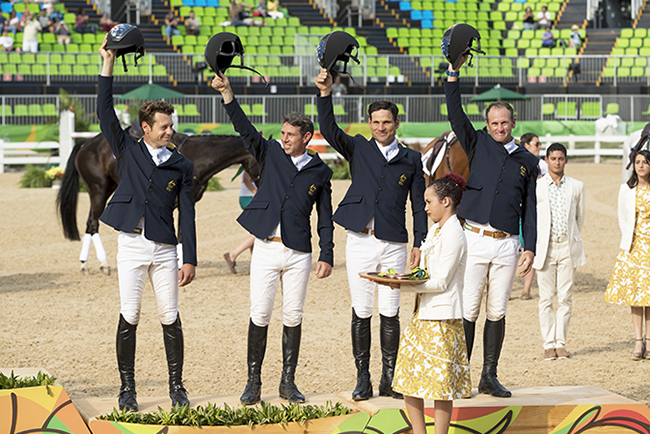
Story by Rebecca Ashton and Christopher Hector
Christoph Hess recently retired from his position with the German Equestrian Federation, which left him free to help with the Australian Squad. When Rebecca Ashton met up with Christoph at Camden, he had just come from working with the British based Aussies – Tim Boland, Andrew Hoy, Christopher Burton, Sam Griffiths and Bill Levett. As an international eventing judge, Christoph is in a unique position to critique our riders.
“I had seven horses to judge. We didn’t ride these horses on grass like here, but on sand. It was a training event. Everyone rode and then we had a video session. I do this when I’m not judging the riders at a championships like the Olympics. I do it also with the German team.”
Do you like the video sessions?
“I like both. I like 20 minutes they ride the test and we discuss or repeat things and then sometimes with a video session, sometimes not, but the people doing the videoing stand behind me, so the riders can hear everything I say. I think it’s important to repeat something. Sit like this, ride the serpentine like that, a lot of technical advice and sometimes general advice, like if the trot is that slow, the horse can’t be in front of you. You have to lift it up bit and have it listen to your leg.”
“For example, a very good horse is Chris Burton’s Santano. He is lovely in the trot, but in the walk he is a little bit close to lateral, not absolutely clean in the rhythm. It’s not bad, but when you look behind the curtain, then you see it could be a problem, so I gave him advice as to what to do. I love doing this, to be more than a judge. The judge’s point of view is one part, and my other hat is the trainer’s point of view.”
“For me Australia is one of the nations who can win medals, like New Zealand, like Germany, like Britain.”
What’s the way forward for us?
“Between 2002-2006, I was on the FEI Committee, when Wayne Roycroft was our Chairman. Wayne said that if we wanted to have better cross country riding, we needed a higher level of showjumping. Chris Bartle and me, we were responsible for the new dressage tests which have been around now for eight years, and we were always very careful, which kind of movements could we ask so that cross country and showjumping would be better, not just some movements, left or right or flying change. No. We wanted something that would help the rider make the sport more safe. This is for me very important, that the riders have a chance to compete in proper dressage and proper showjumping competition. When they just have two eventing horses and they event maybe a total of ten times a year and they ride a total of ten showjumping rounds, that’s not enough.”
“Michael Jung competes the whole Winter 1.50, 1.60 jumping. In summer when he doesn’t have competition, he showjumps. Not pony class, big international level. He wants to compete with the German team in the Nations Cup. I think it is his goal to represent Germany in that. It is really a big challenge for a rider with a different discipline. But he showjumps so much that he has such experience that when he has a track of 1.30 to jump, it’s nothing. That helps him cross country as well. He has a really good eye so he has a good rhythm and he gives the horse good balance. At the end of the day, he has a lot of experience. Riders who don’t have that experience don’t have the self confidence.”
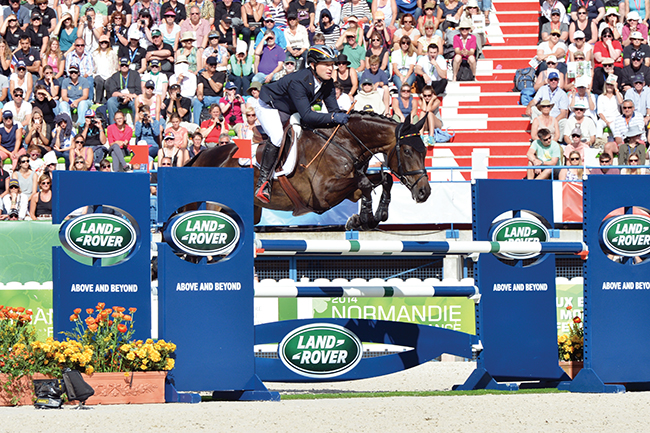
There’s a lot of talk at the moment about changing eventing and the need to increase public interest? Are we trying to fix something that isn’t not broken?
“When I was in the FEI eventing committee, I was in an historic moment there. From long to short format and Wayne, from the political point of view he knew it had to happen, and he had to decide with his head over his heart. This was for me historic and I think it was a step in the right direction. Now we have the big discussion from four to three riders. I know when we had the discussion in the committee to go from four to five riders, it was great, but I knew this rule would not last forever. So now we go the other way back to three. I don’t think that’s a good idea because very easily you can have the best rider in the world winning and he has a lame horse and when you have a lame horse, that’s it, the best team in the world, gone.”
“On the other hand, especially in eventing, it is good from an Olympic point of view to have many flags there, but we have a dangerous sport and when we have riders who have just qualified or who have qualified in quite an easy competition and they now start at the Olympics with Olympic fences and the pressure of Olympics, this is not good. I think, especially in eventing, it is really important to have highly qualified riders. In the pure dressage if a rider has a poor result, ok, nothing happens, therefore in dressage I can understand to have it like this. But in eventing to have it like this, it is not a good decision.”
“On the other hand, and for me I think it is quite exciting, in Germany we have discussed the safety point of our sport. When I was the president of the ground jury in 2004 in essence, the last half year I couldn’t sleep very well because I thought, if something happens there, a killed rider or a killed horse, it’s a nightmare. It’s nightmare always but especially at the Olympics there are cameras everywhere. At the end of the day everyone was talking because Bettina Hoy lost the gold medal, Germany lost two gold medals, that was a discussion for the public, but my heart was much more focused on the rider from Austria. He had a bad fall at the second water. He fell with his horse against the second pole. When you saw it, it could have easily been a broken neck for the horse and rider. Therefore I’m very very much in the direction that we need these safety fences that a fatal accident will be avoided.”
“We will have falls, no doubt. You can’t make the sport as safe as pure dressage, look at the best riders in the world, William Fox-Pitt, Andrew Nicholson, they made mistakes and Michael Jung at Burghley. The first two were really serious accidents that could have paralysed or killed the rider.”
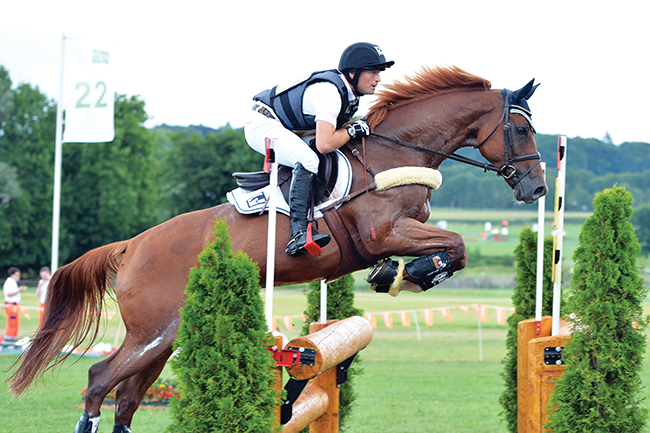 “For me this has to be the important motivation to do as much as possible with safety. We have to practice with these English pins, the Mims system from Sweden, which we use more and more. I’m not an expert in these things, but we need them as much as possible. This to me is very important and very important for the future of the sport. Each fatal accident is a nightmare.”
“For me this has to be the important motivation to do as much as possible with safety. We have to practice with these English pins, the Mims system from Sweden, which we use more and more. I’m not an expert in these things, but we need them as much as possible. This to me is very important and very important for the future of the sport. Each fatal accident is a nightmare.”
“When we lost our young rider Benjamin Winter at Luhmühlen, I was next to the fence. They had held the course because Lucinda Fredericks had had a fall. It was at the end of the day a rider’s mistake but he had such a perfect education and a talented horse, he was not just a rider who wanted to ride 4*. Everything was perfect, like a master plan: Mark Phillips was the course designer, Rüdiger Schwarz was his trainer, Chris Bartle the other trainer, a 10 rated education and everything perfect and this still happens. We need a forgiving situation when a mistake happens. I feel so so very strongly on it.”
“I also don’t think we have the ticket for the next 100 years to have equestrian sport in the Olympic family. It’s very expensive and they think it’s better to have another sport and many other sports are knocking at the door. Now we have golf and rugby.”
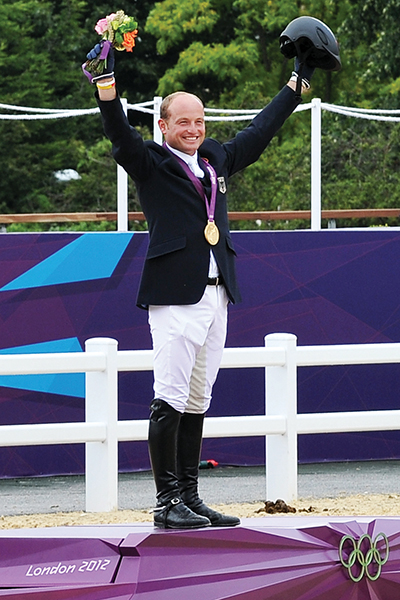
Michael Jung at 2012 Olympic Games
Do you think it still belongs in the Olympics?
“I hope, but I think we have to be open. Four to three riders for me is not a big step. For me we need to think about what is special in each discipline. I know the dressage people hate the idea of having something for the team, like a quadrille – three or four riders riding together. I think it would be very good for the public, you don’t need a lot of time and this is fun. In two hours you have the gold medal and for me this is team. Many think you cannot judge it, but you can, I have a clear picture how you can. This could work for me though I know people don’t like it. Grand Prix is not team. It’s just putting marks together. We need to have vision and a direction to keep our sport in the Olympic family. We have to point out what is the spirit of our sport.”
And there was a time when people didn’t like the music test…
“Yes. I know when we just had the Grand Prix and the Special, many people, especially in Germany, thought that it would be a circus and that good riding would stop. In the end, people now say it would be a boring sport if you didn’t have the freestyle – Dr Reiner Klimke, he was totally against it, and in the end, he came back from Atlanta in 1996 and he said that the spirit of dressage was the freestyle.”
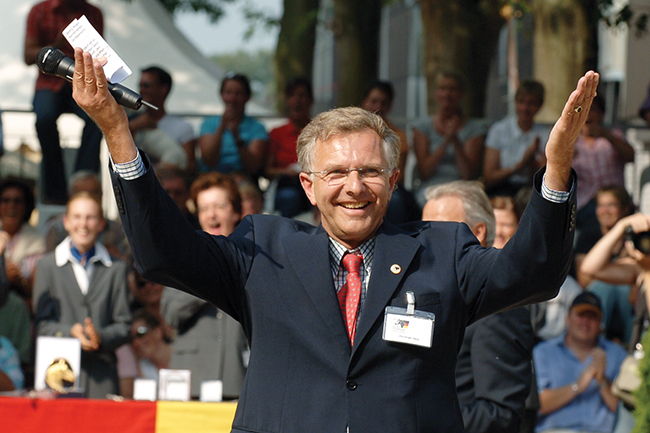 Christopher Hector catches up with Christoph, after Werribee & Luhmühlen…
Christopher Hector catches up with Christoph, after Werribee & Luhmühlen…
I can’t quite remember when I first met Christoph, about 20 years ago. Germany was a somewhat more formal culture then, and I was carefully kitted out in tie and jacket to meet the head of Education at the German Olympic Training Centre, and in walks this smiley, effervescent guy in jeans and an open necked shirt. We’ve had lots of discussions since then and every time you come away amazed at Christoph’s insight, but more than that, his enthusiasm.
I talked to him after the two last big selection events for the Aussies, Werribee and Luhmühlen, to find out how he thought the team was shaping…
You’ve recently spent quite some time in Australia, what are your impressions of our eventers? What are our strengths?
“The strength is the motivation, the strength is that these people are true horse people, and the strength is that they are very very competitive.”
“The other strength is that you still have some very very good riders in Australia – Shane Rose, Stuart Tinney and Sonja Johnson – with Katja Wiemann coming up – these three or four riders are in your country, while New Zealand sends all the good riders to the UK. I think it is a very good decision that you have some top riders in Australia. Why? Because young riders have good examples of how to train, how to compete, how to manage the horses. That is the strength.”
“I think with Stuart and Shane, you have two riders, from my point of view, who have true Olympic potential for this year, with Sonja perhaps half a step behind them. She is not far away.”
“For me, Stuart is an absolutely first class cross country rider. It is amazing how he rides cross country. He is good – plus – in dressage, he is very good in showjumping, and he is excellent in cross country. Shane is from my point of view, very competitive, very concentrated. I have been judging him for a couple of years, and he has made a huge step forward, now for me, he is on a true, high, international level. When I saw him the first years I couldn’t believe how he was riding and how much success he has! But now his way of riding, I like very much.” 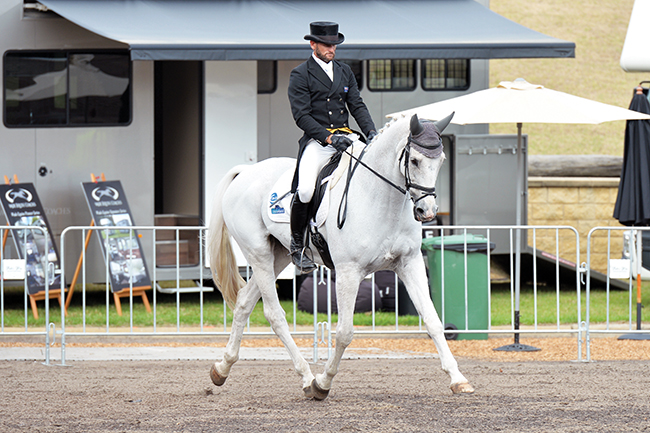
Stuart and Pluto Mio
“Looking at the horses, Stuart has the grey one, Pluto Mio – the question is, is he a couple of days too old? I didn’t see a weakness with him, but it is quite a long trip to Europe and then to South America, but he looks fine. Carlchen, I like very much. The question is – is he 100% ready for this. He did a very nice dressage test in Melbourne. I didn’t see him cross country, I was in control, where I was pushing that we didn’t get too late, because there was a problem with the darkness coming in. I didn’t see Carlchen on course, and I was a little disappointed to hear he had so many time faults. He was clear, but with time faults, and also time faults in the showjumping. I don’t know why and I didn’t get a chance to talk with Stuart about it.”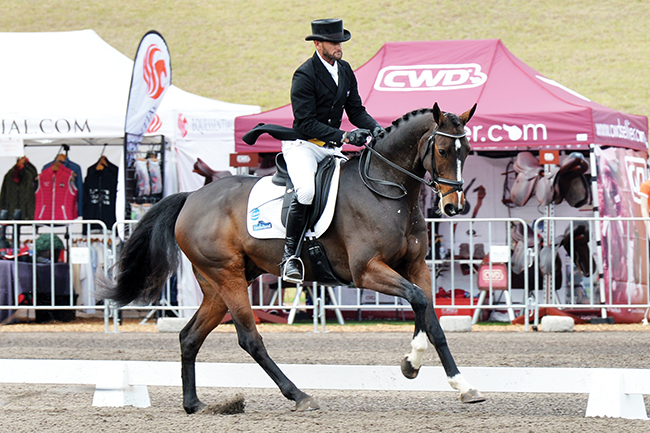
Stuart and Carlchen
“Therefore he has one very experienced horse, maybe a couple of days too old, and one young horse, maybe a couple of days too young.”
“Shane with his CP Qualified, he is always doing a good job. But I remember him when he did his first three-star at Melbourne, and then I saw how exhausted he was when he came to the finish, that was three years ago. So I always have that in my mind when I see him, and think, is he the right horse for South America, because it is very hilly. But this season, every time I saw Qualified he did a true good job.”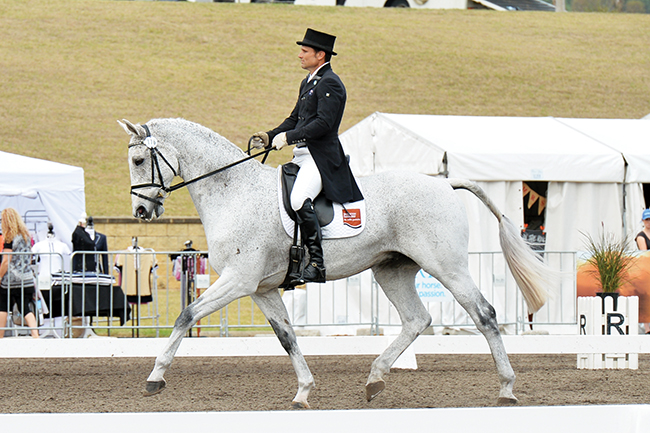
Shane and Qualified
“I like Virgil very much. He missed Melbourne with a virus, but I think he is a horse for the future. When I saw him at Camden he looked like a horse with not a lot of elasticity, the two times I saw him in Sydney, he was much better. I gave Shane some advice and I think Shane is on the good way, he knows how to ride this horse with flexion and more bending to make him more supple. He is a super jumper – he has a lot of Thoroughbred, so maybe for South America, he is the right horse.”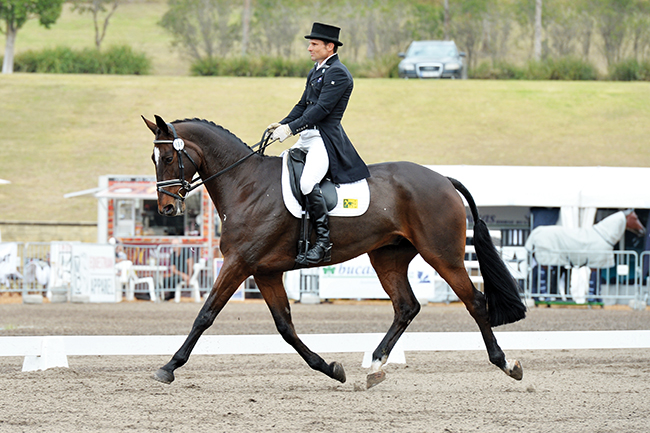 Shane and Virgil
Shane and Virgil
“Sonja with her chestnut horse, the name is too complicated for me, (Parkiarrup Illicit Liaison), has done a huge step forward. He was bad at Camden, he did an okay first test at Sydney and then a truly good second test, and had a wonderful competition. In Melbourne she was good, but not very good, she had an expensive mistake in the serpentines, but the horse has real potential. Sonja is headed to Europe and hopes to ride at Aachen, which is fine, and then if she doesn’t go to Rio, she will compete in Burghley. Sonja is a very good student, I have trained her sometimes, and her weakness is the balance in the saddle, and the horse is I think not so easy to sit, especially in the medium and extended trot, but Sonja has a nice technique – how to find the balance, and in Melbourne, I thought her balance was much better.”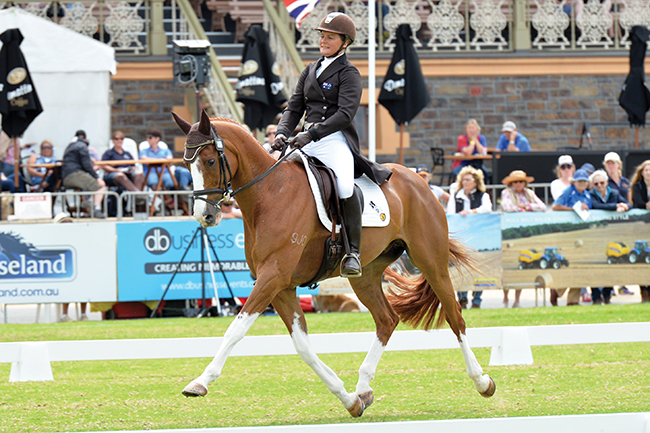
Sonja and Parkiarrup Illicit Liaison
For the future, is it a problem that the three riders you are talking of, are all senior riders and we don’t seem to be bringing on younger riders…
“Some are in the 30’s, the 40’s and even the 50’s. I agree 100%, this is what I was saying when I talked with the High Performance manager, Chris Webb. I said I thought there should be a special focus on the next generation. There are two girls from Western Australia. One is Jess Manson who won Adelaide a couple of years ago, she is a very competitive girl, she needs some help with her dressage skills. I had her in my lessons at Camden, she is brave, she is competitive, she has the right personality to compete – but she needs more basic skills to ride in a proper way, from one point to another on the flat, but this is easier to learn than to learn to be brave cross country. When she has the right horses, I think she will be a good rider for the future.”
“The second young lady is Shenae Lowings. She looks very pretty on a horse, she comes from WA and is under Sonja’s umbrella. She has a lot of talent. She has help from Prue Barrett and back in WA, from Sonja, and these girls need that, they need daily help and someone to manage their horses. Then I think it would be good for these girls to come to Europe.”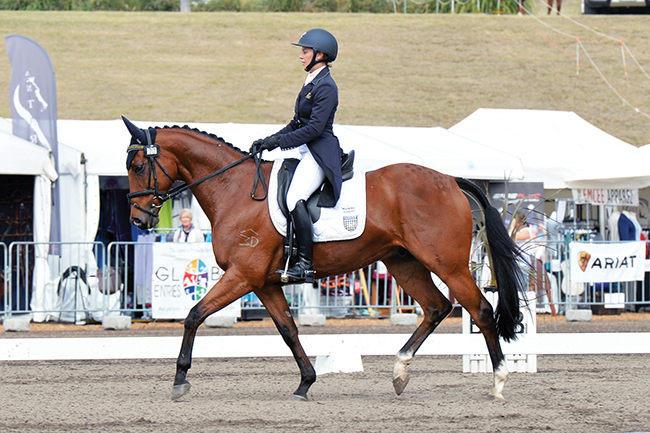
Shenae and Ballyhoo
“I had a good conversation with Andrew Hoy at Luhmühlen, and he said, ‘Christoph, if I was coming from Australia to Europe now, I wouldn’t go to England, I would go to the continent – why, because here there are many more opportunities to compete in dressage and jumping competitions as well as eventing.’ This is very important. Whenever I give advice, I say I think it is important for eventing riders, especially the young ones, have enough possibilities to compete in proper showjumping and proper dressage competitions.”
“When you just compete in eventing competitions, and you have a bad dressage or a bad showjumping and the next competition is not for four or six weeks, that is not a good strategy. It is better to say, okay, next week we have a small showjumping or maybe a small dressage competition, where we can train these things.”
“I think our sport has changed from being an endurance sport, now we have more a sport where you have to be good in all disciplines. In the olden days, you always had to be good in the cross country, and have a well trained, from an endurance point of view, horse – now you need a horse which is super trained in dressage and showjumping and in cross country, therefore you need really good skills in dressage and showjumping and if you don’t, there is no chance of being in the first places.”
Did you see anyone at Luhmühlen that you think will make the team for Rio?
“From my personal feeling at the moment, I would say the ones at this stage in the lead to go to Rio will be Christopher Burton and his black horse, Santano, which is an unbelievable horse. Then Shane and Stewart and also Sam Griffiths…”
“Andrew Hoy is my personal friend, I didn’t judge him, but I saw his dressage on Rutherglen in the four-star. He didn’t halt. The cross country was fine, then in the showjumping, three rails down. The horse is not steady enough. It is very difficult to have him at a high level every day.”
“The other horse, Cheeky Calimbo, I judged in the CIC, he was the overnight leader in the dressage after the first day – I had nearly 80% for him in the dressage, lovely dressage. After the second day he was in second behind Sandra Auffarth. Then cross country, he came out of the Lake and the horse had a run out at the small brush. That’s very very sad, and that is what has happened quite often. Too often there are small mistakes, but at the end of the day, it is 20 penalties.”
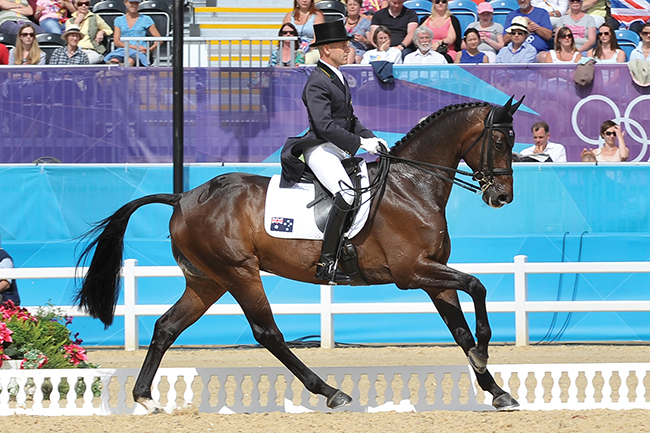
Andrew Hoy and Rutherglen
“Bill Levett with his good horse Improvise, he had a stupid mistake in the four-star. I didn’t see how it happened, I just saw it when he was trying to stop him.”
“With the chestnut horse, Alexander, he did a great job in the cross country and the showjumping. With the dressage, I did not judge it, but I saw it. It was boring, but I spoke with Gareth and Prue later, and Bill had been riding the horse for too long before the test. I had him in a clinic in April and he looked similar. When he is able to give the horse a little more power in the dressage arena, then it is a very good horse. Bill is a nice guy, I think he is very good in a team. My feeling is he is just a step behind, maybe in the reserve position. This is just my own personal opinion, and a lot can happen before they have to announce who is the four, and who is the reserve rider.”
“Alexander is a good jumper but I think he is a good example of a horse that should be trained at proper dressage and showjumping competitions, so he has a strategy of how to warm the horse up for competing in dressage. In Luhmühlen, he was a bit boring and was in the 50’s, but I think he could easily get a 45.”
Is it different working with our Australian riders from what you are used to? In Germany the riders are all trained from a young age in the same way, but our riders don’t have the same basics?
“To be honest, no. The most important thing is that the riders have good motivation, and in Australia, this is ten out of ten. The riders I have in clinics in Australia, are all very motivated, step one. The good ones have the same direction as all top class international riders, we are looking through the same eyes, so there is no problem.”
“Okay in Germany we have one rulebook, but very many different interpretations and many people don’t read the Principles of Riding. If you go to Luhmühlen and Aachen, to the big competitions, yes, they all ride the same way, but if you go to the competitions out in the country, to the pony clubs, then you will see that the level is very similar to Australia. The only difference that we have, is that in Germany most people do not keep their horses at home, most riders have their horses in stables or clubs, so they ride together, they see what other riders are doing. In Australia, many people always ride by themselves and they don’t see other riders riding, and they don’t compete so often because the distances are so long. In Germany, our riders compete quite often.”
“I read the interview you had with Christopher Burton, where he said the difference in Europe is that we can compete so often. The top riders in Germany are always competing, competing and they learn how to train their horses to have good results in competitions, and they see what other riders are doing. This for me is more the difference between the two countries.” 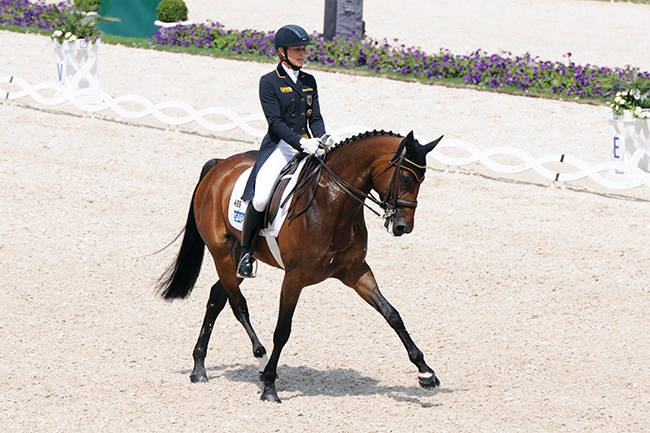
Ingrid Klimke and Escada
“When I started riding there was much more a red line in the training. My generation of riders had instructors who came from the cavalry, trained in a very similar way. In the old days it was very much like that, but the younger generation have trainers who are more specialized, they use the internet, they read this book or that and have their own ideas. Okay, when you look to Sandra or Ingrid or Michi, they all trained in a very similar direction, but these are riders at the highest level. When I look at the lower levels, I see a lot of variation in how they train horses, in how they sit.”
“For me, the biggest challenge is to learn to sit properly and this is problem in Australia, and in Germany, all over the world. Many people are not able to swing enough into the horse’s movement, they don’t think about how important it is to be relaxed and balanced in the saddle, and how important this is for success with the horse. This is not an Australian problem but an international problem.”
There are more articles with Christoph – you’ll find them on his Who’s Who page, right here:



Thank you for the article. Great read. It is always good to get a comprehensive view from an international with such extensive experience. I note his comments on how having top riders here in Australia improves the sport. A pity that more of our dressage Olympians were not also based here.